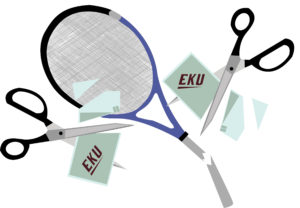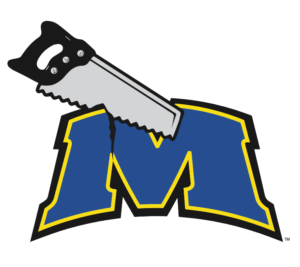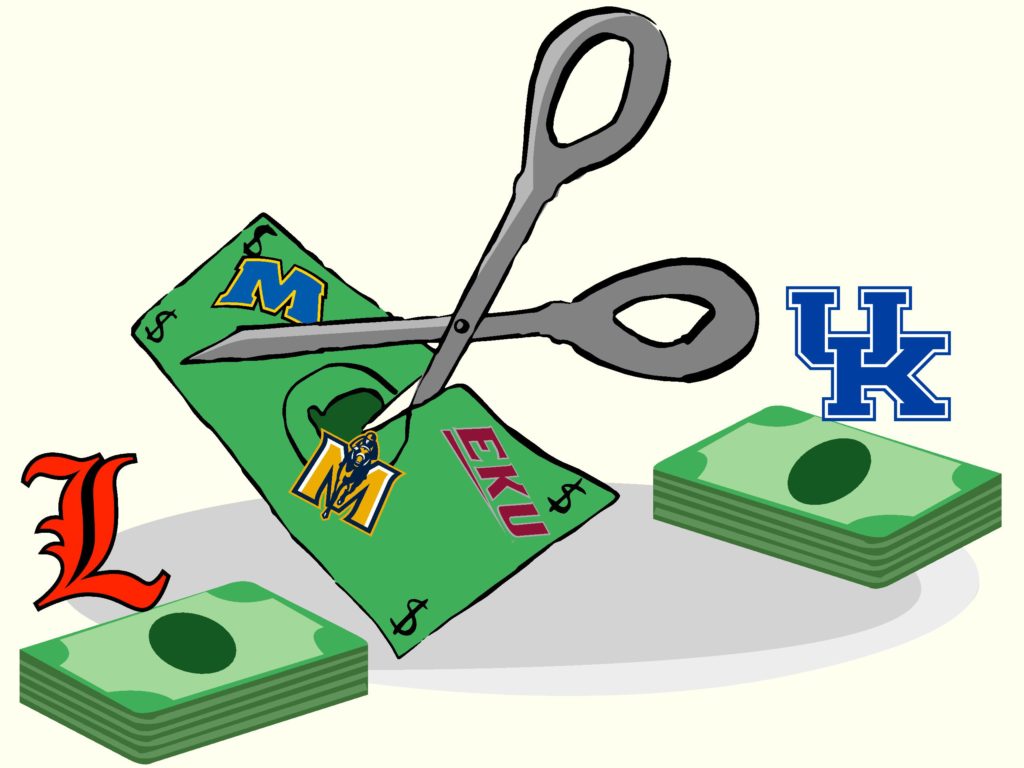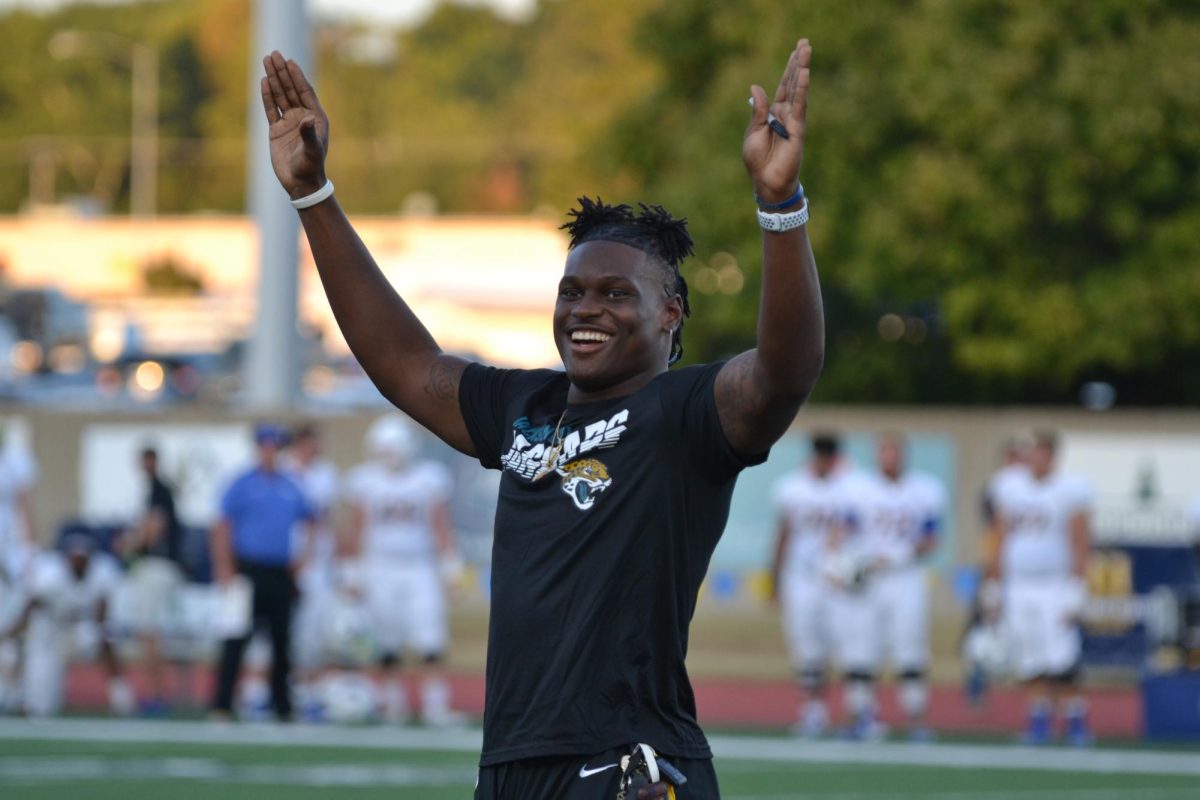Story by Blake Sandlin
Sports Editor
bsandlin1@murraystate.edu
When Kentucky’s General Assembly passed a biennial budget in early April, most of the focus was on its 6.25 percent base cut and increased pension obligations to public universities across the Commonwealth, forcing institutions around the state to restructure budgets from top to bottom.
As universities strived to cut extraneous resources, staff and programs to prevent lofty tuition increases, athletic departments across Kentucky became the inevitable scapegoats. Meanwhile, as regional university athletics faced deep cuts, larger, self-sufficient athletic departments like the University of Louisville and the University of Kentucky survived relatively unscathed.
The Have Nots
The “have nots” comprise school athletic departments in the state who rely heavily on funding from their respective university and are thereby subject to large budget cuts. These athletic departments – Eastern Kentucky, Morehead State, Murray State and Western Kentucky – do not subsidize their respective university, and while they may receive some revenue from their athletic programs, are largely bolstered by the institution itself.
The News reached out to athletic administration from all eight public universities in Kentucky requesting comment about their respective budgets. Four of the eight – Eastern Kentucky, Murray State, Morehead State and Louisville – granted requests for interviews. Western Kentucky and the University of Kentucky were unable to accommodate requests for interviews, though UK director of strategic communication, Guy Ramsey provided comment through email.
Murray State University
Collectively, Murray State trimmed its budget for the 2018-19 year by $7.6 million. However, unlike conference equivalents Morehead State and Eastern Kentucky who opted to freeze tuition and housing rates, Murray State elected to combat university cuts by raising tuition rates by 3 percent, in addition to housing and dining rates, a measure that likely helped the athletic department weather a plethora of cuts.
Nevertheless, Murray State’s athletic department wasn’t completely immune. Although on paper the athletic department came out ahead of last year’s budget ($7,830,254) with a $28,650 increase to the 2018-19 budget, former Murray State athletic director Allen Ward said the increase is a little deceptive. Ward’s comments were obtained before he formally announced his resignation on July 13.
“The increased costs for fringe benefits and tuition and fees is included in that number,” Ward said. “Without those variables, the net effect was a little over $200,000 in cuts for the upcoming fiscal year. I also had to identify another $60,000 in funds to cover increased costs in team travel, officiating, and contractual obligations.”
While Ward managed to stave off eliminating any sports, the most notable cut occurred in the consolidation of the CFSB Center. The arena, which plays homes to men’s and women’s basketball and various events and concerts is now under the athletic department’s umbrella, a move that ultimately resulted in three job cuts and contributed $150,192 of total savings for the university. Included in that cut was the position of building director, which was responsible for overseeing the CFSB Center and Lovett Auditorium.
The implications of that consolidation have been subject to much speculation, as some have rumored that the merger would result in the facility shifting toward being solely used for athletic purposes. However, Ward addressed those rumors, claiming the newly-managed arena will continue to serve as a hub for concerts and entertainment.
“A lot of people ask me, ‘Is it going to be a basketball-only facility?’, and I said, ‘Absolutely not.’ None of that is going to change,” Ward said. “In fact, I hope it grows as to what we’re using it for and how we’re using it. We have got to use that facility to help grow enrollment on this campus. It’s a prime basketball facility; it will always be a prime basketball facility, but we need other events scheduled in there to generate much-needed revenue.”
In total, Racer athletics axed three positions in the department and relocated one other employee. Those positions included the CFSB Center building director, a media relations assistant responsible for women’s basketball, volleyball and baseball and an assistant ticket manager.
As budget cuts continue to loom over postsecondary institutions across the state, athletic departments have suffered extensive cuts to staff in recent years – so much so that Ward believes another round of them could severely impact athletics at Murray State. Those potential cuts, coupled with impending pension obligations next year for state institutions, has Ward constantly and strategically positioning the program for what might lie ahead.
“There aren’t anymore [non-essential positions],” Ward said. “And I’m not saying this to put any pressure on anybody or put anybody in a corner here. We are at a point where it would be very difficult to make any other cuts without it severely impacting what we’re doing. I’m not in the position to cut anymore sports. Division I membership criteria might allow it, but our Title IX obligations won’t.” (Title IX mandates schools provide equal athletic opportunities for men’s and women’s sports.)
In order to address these issues, Ward has taken measures to provide some supplemental income for athletics. He said he has reallocated funding to hire a development officer to grow Murray State’s brand. Also, the athletic department entered into a partnership with Peak Sports Management in May in order to manage and sell corporate partnerships and facilitate marketing.
“Those are all things that we’ve done to put us in a position to continue to grow our revenue, but, of course, I’d like to use new revenue streams to enhance the programs,” Ward said. “It becomes self-defeating to have $200,000 go to budget cuts and not have anything to show for it. That’s very difficult. But it is for the university, as well. We’re just like the rest of the University; we’re all at a point where any further cuts are going to be hard to handle.”
In addition to brand growth, Ward also addressed the possibility of exploring additional revenue streams in the form of guaranteed games, or “money games.” The football program is already slated to play Kentucky this season ($450,000 guarantee) and Georgia next season ($550,000 guaranteed). With a 12-game season for the Racers next year, Ward plans to add another guaranteed game to that schedule in order to make improvements to athletics, but if budget reductions continue, he could find himself using those funds to offset costs.
“If you’re going to play a second game, you’d like to see that benefit the program somehow,” Ward said. “Granted, you can offset some of it in the budget if necessary, but you’d like to say, ‘Hey, here’s equipment, or now we’re going to travel a little bit differently, or we’re not fully funded on coaches right now so we’d like to take a GA and make him full-time’. If we’re going to do it, let’s be sure it helps us advance the program.”
While Murray State’s administration opted to raise tuition for students, others, like Eastern Kentucky and Morehead State, took different approaches. In discussing whether or not he supported raising tuition and other rates in lieu of cutting a substantial portion of athletics and other programs, Ward expressed sympathy toward any school facing cuts.
“My answer is that’s above my pay grade,” Ward said. “The tuition discussion is a board discussion. It’s one that Dr. (Bob) Davies and the Board spend many, many hours trying to come up with a balance between what they need to do from a funding standpoint to offset cuts and continue to provide services for the students, and not placing a larger burden on the students. The state appropriations and the responsibility of the student from a funding standpoint are crossing on the proverbial graph, where state appropriations are going down, and the overall cost to students is going up as a result. And that’s a very difficult equation to balance across all of higher education.”
Eastern Kentucky University

Facing a $25 million deficit, Eastern Kentucky was forced to make the most substantial cuts to its athletic department budget. The school slashed its budget by more than $2 million, a nearly 22 percent cut from its 2017-18 budget.
Encompassed within this $2 million reduction was the expulsion of EKU’s tennis programs, which accounted for $571,560 in the 2017-18 budget. This decision, along with the rest of EKU’s cuts, was finalized on April 6, during which time Eastern’s men’s and women’s tennis teams had matches scheduled in Nashville.
When members of the Budget Advisory committee began exploring potential avenues for cuts, it informed athletics it would be required to cut two sports, and recommended cutting tennis. According to the committee’s Budget Advisory Report, the tennis teams were recommended because:
- Two Kentucky comprehensives (Morehead State men’s and women’s team and Murray State’s men’s team) and several OVC peers have cut their tennis teams in recent years, thus reducing competition in the conference and increasing competition outside the conference.
- There is a limited market for tennis in Kentucky and throughout the Midwest.
- There has been less investment in Tennis than the other teams in recent years.
- Tennis facilities are easily repurposed for other uses.
EKU Athletic Director Stephen Lochmueller said EKU’s predominately international base played an additional role in the decision.
“The rationale was that all of our men’s and women’s tennis players were from foreign countries, so they were international students,” Lochmueller said in a phone call with The News. “Two, so to speak, there wasn’t much of an alumni base there. Three, there was not much of a donor base. When compared to the other options we had inside of our athletic department, because we still had to be compliant with the OVC and the NCAA, and we had to take a look at gender equity and Title IX, so when we looked at that, those were obviously the ones that were recommended, so those were the ones that we moved forward on.”
Raquel Montalvo, a senior tennis player on EKU’s women’s tennis team, said the team had no knowledge that the programs were on the chopping block until the day before, when Lochmueller addressed the potential of the tennis team’s being a target for cuts.
During the match, Montalvo said the team watched a live stream of the Board of Regents meeting helplessly, as the fate of their programs laid in the hands of University officials. Ultimately, the women’s tennis team responded resoundingly, not only winning their Friday match against Belmont, but going on to finish their conference season undefeated and winning the OVC tournament.
“It was hard times until we won the championship, and hoping that they would change their minds,” Montalvo said. “In the end, the team handled it professionally.”
The school is granting players on the tennis teams a full release to transfer. Montalvo said out of the five returning players, four of them were pursuing transfer options. If they choose not to, Eastern Kentucky will honor their athletic scholarship through their graduation. However, the timeliness of the cuts, coupled with the burdensome transfer process, made the decision difficult for athletes.
“Since it was already so tight on time, almost summer break, some girls had a lot of difficulties while checking other universities,” Montalvo said. “I can see from them that it was the most difficult decision to make. Because we are still hoping that the program can be reinstated; once you sign with another university, you cannot come back. Plus, they have to check if all their credits were transferable, and other stuff. All that during finals week and most of those days before leaving to their homes outside from the USA.”
However, these cuts comprise just a share of the damage EKU’s athletic department has taken at the hands of budget shortfalls. Lochmueller reported that his department has been forced to cut nearly $3 million over the past 18 months, cutting with it a significant portion of essential staff and operational resources imperative to the functionality of the athletic department.
According to the Budget Advisory Committee, the reduction was justified because the athletic department had previously increased their budget in 2014 in an unsuccessful effort to gain a Football Bowl Subdivision (FBS) bid into the Sun Belt Conference. The cuts to the athletic budget officially ended their pursuit of an FBS bid, and effectively returns their budget to pre-bid levels.
Eastern Kentucky announced it would be cutting 153 full-time positions at the school. Among those, athletics will be cutting the following positions: both men’s and women’s tennis coaches and staffs, a senior office associate, a deputy athletic director, a director of basketball operations for men’s and women’s basketball, a sports performance director, program assistant, athletics administrative assistant and a life skills coach.
“Personnel has been one of the hardest cuts we’ve had to make because we’re not overstaffed,” Lochmueller said. “We’re understaffed, that’s why we actually have to rely on some insourcing from other folks to come and help us with our game operations.”
Despite the extensive amount of reduction to staff and programs, the athletic department still fell short of the 22 percent cut it was required to make. Thus, they were forced to undergo several revenue-generating measures in order to offset the remainder of the cuts.
Lochmueller said at least a third of the proposed reductions were supplemented through future measures beginning in 2021, like adding a guaranteed football game every year, two additional guaranteed basketball games and exploring the potential for guaranteed games in other sports.
“We’re going to have to require some of our other programs to start picking up some games like softball, baseball, volleyball, wherever we might have the opportunity to pick up some nice revenue,” Lochmueller said. “Those revenues range anywhere from 5,000 dollars a game, all the way up to half a million for a guaranteed football game.”
The shortfall has prompted athletics to adopt a more frugal approach to its operations, beginning with how games are scheduled for individual teams. Cuts to expenditures in the department will affect game scheduling. Lochmueller said over the next two years athletics will shift toward adopting an increasingly regional approach to scheduling in an attempt to avoid using airlines for travel to and from games.
Morehead State University

More than one hour east of Eastern Kentucky lies Morehead State, an institution dealing with its fair share of budget bleeding. The university opted to forego raising tuition and housing costs when it finalized its budget on June 7. Morehead’s 2018-19 budget includes a 3.2 percent cut from the previous year, a decrease of $4.9 million.
Morehead State athletics haven’t been immune to cuts in the past. The athletic department cut its men’s and women’s tennis teams in the face of looming cuts in 2016, causing Morehead State Athletic Director Brian Hutchinson to be adamant with this time around that turning to sports for a cut was a bad idea.
Morehead State President Jay Morgan agreed, but the athletic department wasn’t out of the woods yet.
The already strapped athletic department was forced to slash approximately $500,000 from its budget. Morehead State’s 2017-18 budget, set at $8.8 million, was reduced significantly to $8.3 million for the upcoming fiscal year.
Hutchinson said the department was tasked with cutting approximately $514,000 initially, but managed to cut nearly $600,000 from its budget.
“For us, the $514,000 that we started with, that was our 6.25 percent,” Hutchinson said in a phone call with The News. “That was our portion of what that distribution was that we got that the University gave us out of those funds. It’s gone beyond that, because we’ve just tried to get to a balanced budget for the university, and so beyond that part is where it gets really hard for us, where we’ve got to be really creative.”
Encompassed within those reductions was the elimination of four full-time staff positions: a men’s basketball operations position, a media relations position, an operations coordinator and a football secretary position.
The department plans to do away with some of the athletic facilities. Hutchinson also implemented a 5 percent cut to team travel across the board. The travel cuts have forced the athletic department to reevaluate how they schedule.
“I don’t know if any of my teams have a game on their schedule that would put us on a plane this year,” Hutchinson said. “We’re trying to be as economical as we can. Other than Marshall and Eastern Kentucky, two teams that we regularly play in about everything, everybody else we play we’re spending the night somewhere because we’re just not close to anyone. Extra night in hotel, buses, etc.”
Positioned at the bottom of the Ohio Valley Conference in terms of budget size, Morehead State was already substantially behind its OVC counterparts, and the most recent cuts only compound that. Fortunately, the Commonwealth delayed university pension obligations, a decision that could have proved dire to the athletic department’s viability.
“Had we had the 6.25 cut, plus those pension obligations, plus fixed and unavoidable costs and all the other things that go into that, it could’ve been nearly catastrophic for us,” Hutchinson said. “I don’t want to use too strong a word, we’re in the business of higher ed, in many ways this isn’t life or death, but it’s very important to a great group of the population. So in terms of how we operate and do some things, if all of those things would’ve lined up this year, it would’ve been very, very difficult.”
Because of Morehead’s budget size and small staff, Hutchinson said his department has always adopted an all hands on deck approach to the job, but that maxim could take on a whole new meaning as the year goes on.
“I’ve always said if we have a home football or basketball game, all of my administrative team needs to be there,” Hutchinson said. “Just in case. But that probably now means, though, that you don’t just need to be there, you may be selling tickets or you may be in the concession stand when we shut the doors down working with the theatre students running it that day to help them clean or to help count the money or to make sure that the inventory is still right. I may be doing that myself in some instances, because that’s where we are now. It’s a much different feel as we go into next year, that’s for sure.”
The reality of the cuts has forced Morehead State to explore supplemental revenue streams. However, different from sister schools in the state such as Eastern Kentucky and Murray State, Morehead State is handicapped by its inability to acquire guaranteed football games with larger power-five schools – games that pay generous sums.
Because of the Eagles’ status as a non-scholarship football program, bowl-eligible teams are unable to schedule Morehead because the matchup doesn’t count toward those teams’ bowl eligibility.
“We’re at a distinct disadvantage to Murray or Eastern or any of those schools because those games just aren’t available to me, and that’s a significant $3-500,000 a year that we just can’t get,” Hutchinson said.
That leaves Hutchinson and Morehead desperate for additional revenue streams. Yet, in a small local market like Morehead, Kentucky, the community can only provide so much. While schools like Louisville and UK can rely on large donors and a bottomless well of community support, Hutchinson is skeptical his school can survive on local support alone.
He points to deals like Murray State’s recent partnership with Peak Sports (an advertising and event management firm), as well as internal strategies, as potential avenues to pursue in an effort to grow Morehead’s brand on a national and global scale.
“When you can align yourself with them and they will guarantee you revenue, that’s a place to go,” Hutchinson said. “Being creative in ticket sales and trying to drive, and maybe you involve more group sales by lowering your ticket prices, but you increase your volume. We’ve got to think through that. We’ve got to try to think through that; we’ve got to try to push more season ticket sales, whether it be for basketball or even for places like soccer or softball because that is guaranteed revenue. We’ve got to push concessions; we’ve just got to push.”
In a time when staff and resources are at an all-time low, Hutchinson has to be careful not to push too hard. Despite all of the setbacks, the 14-year athletic director remains steadfast in his belief that Morehead State can still accomplish a lot with a little.
“The biggest thing that we’ve got to continue to do is keep everyone motivated towards the goal of being what we should be and representing the University,” Hutchinson said. “We should take that investment seriously; we need to try to win, we need to try to do that well. Otherwise I’m not sure that we’re doing the University a service that we should serve.”
The Haves
While regional universities’ athletic budgets are being cut to the bone, national schools, which operate predominantly independent of their universities, continue to thrive.
Athletic departments like the University of Louisville and the University of Kentucky function largely separate from their universities, rendering them mostly immune to the daunting budget cuts that the majority of regional schools are facing.
For the most part, Louisville and UK aren’t subjected to the various cuts that their respective universities make because they are predominately self-sufficient.
University of Louisville

No school exemplifies that reality more than Louisville. One of the highest-grossing athletic departments in the nation, Louisville athletics are flourishing amid state cuts.
While the university itself enacted a 5 percent across-the-board cut to Louisville’s general fund, resulting in a 3.5 percent tuition increase for in-state students, Louisville athletic department was essentially exempt from any cuts.
Louisville Athletic Director Vince Tyra said his department relies on about 10 percent of its budget funding from the University. The remaining 90 percent is generated through various revenue streams such as ticket sales, licensing deals, donations and TV deals – a narrative vastly different for mid-majors in Kentucky and beyond.
“When you get into some of these smaller mid-majors or less, they may be in the range of 50 or 60 percent of the athletic budget that comes from the school, which is really coming from the state,” Tyra said. “So they take significant hits; they don’t have the benefit of a large conference that has large media rights, and certainly a much larger donor base.”
The majority of the funding that athletics receives from the university comes in the form of student athletic fees and gender equity. Given the budget shortfalls, the university slashed gender equity and utilities for some facilities from its budget, forcing the athletic department to cover those expenses in their 2018-19 budget, an event Tyra likens to a cut. He estimates the school currently provides about $7 million of aid to athletics.
The first-year AD said he hopes to phase out university support to the point where athletics is operating entirely independent of the school within the next 3-5 years. UK’s athletic department already functions this way.
That’s not the only difference between Louisville and other schools in the state. Louisville, as well as UK, employ a budgeting method called “zero-based budgeting.” Different from traditional budgeting strategies utilized by regional schools like Murray State, Eastern Kentucky and Morehead State, which demand making incremental increases to previous budgets, zero-based budgeting gives schools more flexibility in their spending.
With zero-based, Louisville doesn’t budget for the 2018-19 fiscal year beforehand. Instead, it starts with a “zero base” and justifies expenses as necessary.
With ever-changing variables to consider at a school of Louisville’s stature, Tyra said zero-based budgeting provides spending flexibility to the school.
“I think some schools just say, ‘Well, here’s your budget from last year and you get a 2 percent increase or a 2 percent decrease.’ We don’t look at it like that,” Tyra said. “We think it’s proper to go year-by-year, sport-by-sport because for one, the scheduling. And if we do have to tighten our belts, we kind of look at saying ‘You’re not entitled to $1 million this year, you’re only going to get $900,000 because we’re just not going to give you the benefit of maybe those road trips or tournaments across the country.’”
During the 2017-18 season, Louisville’s football budget alone was slightly less than $19 million – a budget more than double the size of Murray State’s total athletic budget. The Cardinals pulled in $38 million in football revenue and $27.8 million in basketball revenue.
Of the combined $65.9 million in revenue from Louisville’s most profitable sports, the largest percentage came from ticket sales, totalling more than $28 million, about 43 percent. In total, Louisville athletics grossed $113.6 million in revenue last year.
So as budget shortfalls loom over regional universities in the state, larger school athletic departments are left predominately unscathed. However, while others are grappling with budget woes, administration within the Louisville athletic department faces a vastly different conundrum.
If smaller mid-major schools are allegiant to their academic institutions, then large powerhouse schools are allegiant to donors and fans. That notion was clearly evident over the past year, as Louisville found itself embroiled in several controversies that cause donor support to waver more than ever.
With almost $16.8 million in revenue stemming from annual seat donations and $28 million in ticket sales, it’s no hyperbole to state that fan support is paramount at Louisville. But when ex-Louisville Head Coach Rick Pitino was referenced in a federal investigation into recruiting fraud and corruption last September, fan and donor trust in the program faltered.
Pitino, as well as longtime athletic director Tom Jurich, were fired, ending a tenure with the program tainted with controversy. Yet for Louisville athletics, distancing itself from Jurich and Pitino wasn’t enough to restore confidence in the athletic program – a reality Tyra quickly discovered firsthand.
“I’ll say the first half of the basketball season last year we did (feel donor impact), and then it improved,” Tyra said. “I’ll say it got back to normal during the back half. It definitely did. We had donors that had paused their donations or had maybe held out on some pledges, and that had some impact. So for us it makes us think about what we’re doing in our budget. We tried to be thoughtful about that and took what those trends were and rolled them into our budget. It has definitely had an impact. We didn’t have the flexibility in the budget that we would’ve liked to have.”
Notably, basketball ticket sales originally budgeted to gross $16,290,000 actually made $13,998,479, likely a direct correlation to the recruiting scandal. Seat donations totaled approximately $200,000 less than estimated.
Thus, healing the wounds and reestablishing donor trust in the program has been a key priority for Tyra in his first year in order to cultivate a strong base for his department and ensure sustainability for years to come.
“I think just making good decisions and then frankly talking about it [can build trust],” Tyra said. “I think we had to fix some things internally, and I think gaining their trust is key. That they trust that what we’re doing has been fixed and what we’re doing internally by making good decisions. And then making them feel more apart of it. I think we’re worked hard to make our donors and our ticket holders feel more apart of our programs. Get them a little closer to the program and let them see what we’re doing and be apart of it.”
But for smaller Kentucky schools with a limited donor base, that same luxury isn’t available. While Tyra himself has little to worry about in terms of state budget cuts, he does sympathize with the future of collegiate athletics. And if cuts to higher education continue, the Murray States of the world could face a daunting future.
“I hate to say it, you really are relying on the donors,” Tyra said of smaller schools. “Whether they be your corporate citizens in the states, if you talk about Murray or Western, Bowling Green certainly with Fruit of the Loom being based there and others, you really do kind of look to these companies to help you be viable. You like to think that’s where their future employees are coming from is from those universities, and they’d like to be supportive to the max amount that they can. But it’s tough. Unless you have enough high net worth or companies in the community; we’re obviously in a good position at Louisville because we’re in the largest city in the state and we have more companies based here and more population and employees, but when you get into the smaller communities and smaller state schools, you’re really relying on those local accounting firms, law firms, banks, anybody you can to engage or the business model’s not going to work.”
University of Kentucky

(The News reached out to UK Athletic Director Mitch Barnhart, but he was unavailable for comment at the time of this story.)
Slightly different from Louisville, the University of Kentucky’s athletic department functions entirely independent of its university.
For the 2018-19 fiscal year, UK anticipates an operating budget of $147.7 million. UK, like Louisville, also employs zero-based budgeting to service its sizable budgetary needs.
“We take this approach because every year is different, bringing new expenses, new challenges and new opportunities. Since the world of athletics is ever-changing, we must take a flexible approach,” Guy Ramsey, UK director of strategic communication, wrote in an email to The News.
Not only does UK Athletics maintain the resources to operate self-sufficiently, it even contributes to the university through academic scholarships, fees and facilities.
“In 2018-19 alone, UK Athletics will contribute $1.7 million for academic scholarships; pay the full rate for 330 athletic scholarships ($17.9 million); and pay a university assessment fee of $2.3 million, all while continuing to fund $65 million – about two-thirds of the cost – of the Jacobs Science Building,” Ramsey said.
Ramsey also added that for the first time UK Athletics did not require students to pay a mandatory student athletic fee, which benefits athletics, provides access to facilities and leverages free or reduced ticket prices.
Like its revenue counterpart in Louisville, a strong donor base is equally important to the Wildcats’ sustainability. According to the UK Athletics Department Budget Report, donors’ contributions comprise 18.8 percent of the department’s total revenue.
For comparison, UK men’s basketball accounts for a share of 19.7 percent of the athletic department’s total revenue. Contributions to the K Fund, UK’s fundraising arm, are estimated to total $27.7 million this fiscal year.
“While budget cuts to higher education may not directly affect UK Athletics, they do have an impact,” Ramsey said. “Though we may operate independently from a financial perspective, we are part of the University of Kentucky.”
____________________________________________________________________________________________
As each Kentucky institution embark on the 2018-19 school year, they will do so with the intent of thriving amid budget turmoil. Though the narratives vary from school to school, one thing is for certain: the maxim “survival of the fittest” isn’t simply reserved for the court or field – it’s embodied just as strongly through athletic departments statewide.





























































































